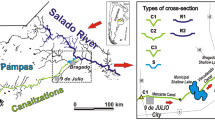Abstract
Four ecological zones of the Gambia River were sampled during four different hydrologic seasons for determination of microbial, nutrient, and physical parameters. A Greco-Latin Square experimental design was used to define the particular transect, station, depth, and tide/time-of-day of samples taken. Ranges of total bacterioplankton densities (106 cells/ml) were similar to those of tropical and temperate environments. Numbers of free bacteria were similar temporally, whereas attached bacteria numbers were greater during periods of high stream flows when suspended solids concentrations were higher. Free bacteria were usually twice as numerous in the freshwater zones than in the estuarine zones. Attached bacterial densities were approximately four times greater in the estuarine zones than in the freshwater zones. Uptake of3H-glucose on both a sample volume and per-cell basis increased from the early stages of the flood (6.95±SE 1.37 ng/liter/hour and 3.8 pg/hour/106 cells, respectively) and reached observed annual maximums during the dry season (21.01±SE 3.05 ng/ liter/hour and 13.0 pg/hour/106 cells, respectively). Spatially,3H-glucose uptake per sample volume and per cell was highest in the upper river zone and lowest in the lower estuary zone. The lower estuary zone consistently acted out of concert with the other river zones in terms of3H-glucose and14C-bicarbonate uptake. Analysis of variance (ANOVA) indicated that free and attached bacterioplankton densities were not homogeneous among transects, stations, depths, and tide/time-of-day at the different zones during the four hydrologic seasons. The results suggested that heterotrophy overshadowed autotrophy in the river and that the bacterial abundance, distribution, and glucose uptake activity in this tropical floodplain river were greatly influenced by the annual flood and the presence of extensive mangrove forests in the estuary.
Similar content being viewed by others
References
Azam F, Fenchel T, Field JH, Gray JS, Meyer-Reil LA, Thingstad F (1983) The ecological role of water-column microbes in the sea. Mar Ecol Progr Ser 10:257–263
Azam F, Holm-Hansen O (1973) Use of tritiated substances in the study of heterotrophy in seawater. Mar Biol 23:191–196
Bell CR, Albright LJ (1981) Attached and free-floating bacteria in the Fraser River estuary, British Columbia, Canada. Mar Ecol Progr Ser 6:317–327
D'Elia CF, Stendler PA, Corwin N (1977) Determination of total nitrogen in aqueous samples using persulfate digestion. Limnology and Oceanography 22:760–764
Hall CAS, Moll RA (1975) Methods of assessing aquatic primary productivity. In: Leith H. Whittaker RH (eds) Primary productivity of the biosphere. Springer-Verlag, New York, pp 19–52
Hobbie JE, Crawford CC (1969) Respiration corrections for bacterial uptake and dissolved organic compounds in natural waters. Limnology and Oceanography 14:528–532
Hobbie JE, Daley RJ, Jasper S (1977) Use of Nucleopore filters for counting bacteria by epifluorescence microscopy. Appl Environ Microbiol 33:1225–1228
Imevbore AMA, Bakare O (1974) A pre-impoundment study of the swamps in the Kainji Lake basin. Afr J Trop Hydrobiol Fish 3, 1:79–93
Menzel DW, Corwin N (1965) The measurement of total phosphorus in seawater based on the liberation of organically bound fractions by persulfate oxidation. Limnology and Oceanography 10:280–281
Neter J, Wasserman W (1974) Applied linear statistical models. Richard D. Irwin, Inc, Homewood, Illinois
Nixon SW (1981) Remineralization and nutrient cycling in coastal marine ecosystems. In: Neilson BJ, Bronin LE (eds) Estuaries and nutrients. Humana Press, Inc, pp 111–138
Palumbo AV, Ferguson RL (1978) Distribution of suspended bacteria in the Newport River estuary, North Carolina. Estuar Coast Mar Sci 7:521–529
Rublee PA (1982) Seasonal distribution of bacteria in salt marsh sediments of North Carolina. Estuarine, Coastal and Shelf Science 15:67–74
Schmidt GW (1970) Number of bacteria and algae and their interrelations in some Amazonian waters. Amazonia 2:393–400
Strickland JDH, Parsons TR (1972) A practical handbook of sea water analysis. J Fish Res Board Can 167
Sverdrup HU, Johnson MW, Fleming RH (1942) The oceans, their physics, chemistry and general biology. Prentice-Hall, Englewood Cliffs, New Jersey
Thornton I (1965) Nutrient content of rainwater in The Gambia. Nature (No. 4975) 205:1025
Visser SA (1973) Pre-impoundment features of the Kainji area and their possible influence on the ecology of the newly formed lake. In: Ackermann WC et al. (eds) Man-made lakes: their problems and environmental effects. Geophysical Monograph 17, American Geophysical Union, Washington, DC
Wetzel RG (1975) Limnology. WB Saunders, Philadelphia
Williams PJ leB (1981) Incorporation of microheterotrophic processes into the classical paradigm of the planktonic food web. Kiel Meeresfor Sonderh 5:1–28
Winer BJ (1976) Statistical principles in experimental design. McGraw-Hill, New York
Wright RT (1978) Measurement and significance of specific activity in the heterotrophic bacteria of natural waters. Appl Environ Microbiol 36:297–305
Wright RT, Burnison BK (1979) Heterotrophic activity measured with radiolabelled organic substrates. In: Costerton JW, Colwell RR (eds) Native aquatic bacteria. American Society for Testing Materials, Philadelphia, pp 140–155
Wright RT, Coffin RB (1983) Planktonic bacteria in estuaries and coastal waters of northern Massachusetts: spatial and temporal distribution. Mar Ecol Progr Ser 11:205–216
Wright RT, Coffin RB (1984) Measuring microzooplankton grazing on planktonic marine bacteria by its impact on bacterial production. Microb Ecol 10:137–149
Author information
Authors and Affiliations
Rights and permissions
About this article
Cite this article
Healey, M.J., Moll, R.A. & Diallo, C.O. Abundance and distribution of bacterioplankton in the Gambia River, West Africa. Microb Ecol 16, 291–310 (1988). https://doi.org/10.1007/BF02011701
Issue Date:
DOI: https://doi.org/10.1007/BF02011701




